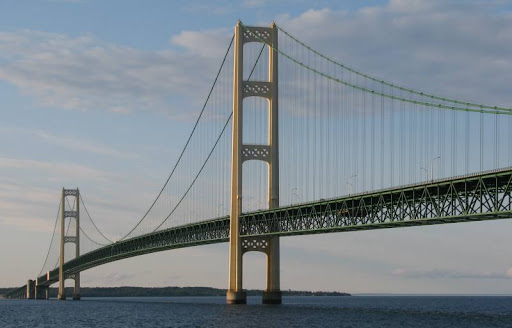
PEOPLE USED TO travel between the UP (Upper Peninsula) and LP (Lower Peninsula) of Michigan by ferry until they built a bridge along the Straits of Mackinac…
In 1934, the Michigan Legislature created the Mackinac Straits Bridge Authority to study the feasibility of the bridge and authorized it to sell bonds for the project. Preliminary plans for the bridge featured a three-lane roadway, a railroad crossing on the under deck of the span, and a center-anchorage double-suspension bridge configuration similar to the design of the San Francisco-Oakland Bay Bridge. From 1939 to 1941, a cause-way of approximately 4,000 feet in length was constructed with concrete road fragments extending from the northern shore. With uncertainty in funding and the initiation of World War II, further building was delayed. In 1950, engineers resumed construction and the state legislature authorized the sale of $85 million in construction bonds on April 30, 1952.
David B. Steinman was appointed the design engineer in January 1953, and the American Bridge Division of United States Steel Corporation was awarded a contract of over $44 million to build the steel superstructure. On November 1, 1957, after two-and-a-half years of construction and the loss of five lives, the bridge finally opened to traffic. It was officially dedicated on June 25, 1958. The bridge is approximately five miles long, the third longest in the United States. Forty years after the dedication, the 100-millionth crossing was celebrated.
Most of us probably look at the construction of this bridge as a feat of modern engineering. True enough, it is. But behind the construction was the need: the need to connect two cultures and two land masses, to expand and improve economic prosperity by bringing people together.
Did the bridge spring up immediately? No.
How did it start?
With a vision, a picture in the minds of visionaries of what it might resemble and how it might change the lives of all affected by its construction. When it became clear that ferries were too expensive and too inefficient to accomplish the goals of connecting the two sides, the bridge came to the forefront of everyone’s mind. The old ways of transportation just were not working. Something new had to be put into place.
What it cheap? No.
Was it easy to build? No.
Were human lives put in danger? Yes.
Was it worth the cost, the hardship, the lives lost, the requirements of years of work and commitment to make this bridge happen?
For most people connected with the bridge, the answer was an overwhelming yes.
THOUGHT: Like suspension bridges built across bodies of water, it takes time, money and risk for bridges of healing to be built between estranged people. Many may feel that the cost is too high to achieve the bridge. It might cost me time or pride. I might have to say I’m sorry. What if the person to whom I am trying to direct my bridge laughs at me, scorns me or refuses my overture – or worse yet, just plain ignores me?
Jesus said that we must count the cost of discipleship (cf. Luke 14:28). Building bridges that result in restored relationships is probably one of the most important costs of being a disciple of Jesus. Christ taught that reconciled relationships are more important to God than any offering we could bring before Him.
Why?
Because for God, how we treat others is synonymous with how we treat Him (cf. 1 John 4:20). (H. Norman Wright, Larry Renetzky)
“Therefore if you bring your gift to the altar, and there remember that your brother has something against you, leave your gift there before the altar, and go your way. First be reconciled to your brother, and then come and offer your gift.” Matthew 5:23-24